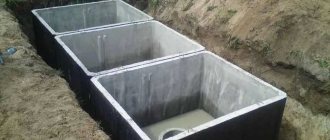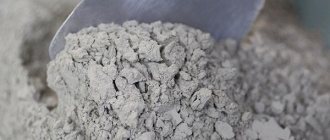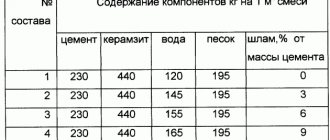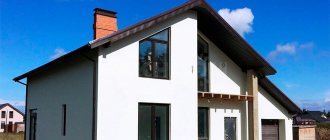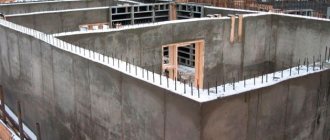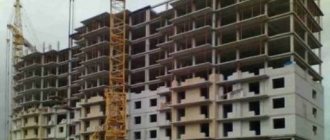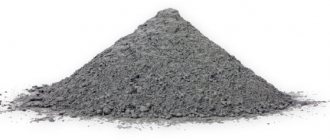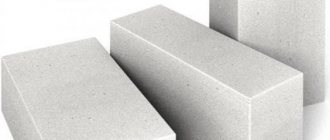The optimal material for construction is monolithic expanded clay concrete; with its help, you can build any structure inexpensively and in a short time. Experienced builders speak positively about the material and use it in all areas of construction.
Expanded clay concrete is a type of lightweight concrete; the expanded clay contained in the composition gives the finished product lightness, in comparison with ordinary concrete, and increased thermal insulation properties. Expanded clay is made from certain types of clay, which foam during the firing process.
The composition of expanded clay concrete includes:
- Cement;
- Sand;
- Expanded clay;
- Purified water;
- Additives and plasticizers.
Manufacturers allow the exclusion of sand from the composition when making mortar for monolithic structures.
Expanded clay concrete has been used for construction for the last 50 years; it has proven itself only on the positive side. Monolithic structures are reliable and durable, high thermal insulation rates allow you to save on wall insulation, and their low weight reduces the cost of preparing the foundation.
Manufacturers produce several types of expanded clay concrete; depending on the functionality and strength grade, it is divided into three types:
- Structural – used for the construction of load-bearing walls and floors, strength grade from M100 to M300;
- Structural and thermal insulation - used for the construction of interior partitions, small one-story structures (utility room, fences), strength grade from M50 to M75;
- Thermal insulation is an excellent option for insulating and soundproofing buildings; it is not suitable for construction.
In this article we will consider in detail the issues of monolithic construction from expanded clay concrete, learn the pros and cons of the material, and why monolithic expanded clay concrete is used. We will also analyze the process of laying the monolith and tell you about the main stages of construction work.
Pros and cons of houses made of expanded clay concrete
Advantages
- Minimum load on the foundation. The porous structure of the blocks reduces their weight compared to brick. This allows you to save money when arranging load-bearing structures.
- High strength and durability of walls. Expanded clay concrete is allowed for the construction of load-bearing walls, but solid blocks must be used. The material is suitable for basements and multi-storey buildings. The durability of expanded clay concrete is due to the fact that it is able to withstand many freeze/thaw cycles.
- Low cost of building a box house. It is easier to work with expanded clay concrete than with heavy, but smaller bricks, which means that its masonry will cost less.
- Minimal shrinkage. Cracks do not form on the walls made of expanded clay concrete during the operation of the house. But it is important that during the production of blocks all technical processes are followed, including its final drying.
- Low level of thermal conductivity of walls. A house made of expanded clay concrete is initially very warm. Previously, expanded clay, which was part of the blocks, was used to insulate attics and brick walls.
- Eco-friendly home. Expanded clay concrete does not contain any toxic or environmentally harmful components. Such housing is absolutely safe for human health.
- High level of sound insulation. There is no need to apply additional finishing to protect against noise from the street. But if the house is located near a busy highway, then you should also think about installing windows with additional sound insulation.
- The walls are protected from rodents, insect pests and other biological damage. There is no need to regularly treat walls with fungicidal or antiseptic compounds.
- The walls “breathe”. Inside a house made of expanded clay concrete there is never a “thermos effect”, which is a problem for properties made of brick or many other artificial blocks. At the same time, the material is not blown through like shell rock, so heat is well retained indoors in winter.
- The walls are securely held by fastening elements, such as anchors. You cannot screw a self-tapping screw into expanded clay concrete, but a dowel with a plug will fit in easily. Therefore, hanging a shelf on the wall will not be difficult.
Flaws
- High level of water absorption of walls. This drawback only applies to blocks that contain more expanded clay than concrete. Usually they are used only for laying partition walls.
- The material crumbles. This indicates the low quality of the concrete that was used to make the blocks. Therefore, for construction you should purchase only certified products from reliable suppliers.
- Difficulties in fixing fasteners. On the one hand, the high strength of the material is its advantage, but on the other hand, to fix the dowel in the wall, you will first have to make a hole in it using a hammer drill.
- Unaesthetic appearance of blocks. Both the outside and the inside of the walls require finishing. In addition to its attractive appearance, it will also protect expanded clay concrete from moisture.
- High level of water absorption of walls. This drawback only applies to blocks that contain more expanded clay than concrete. Usually they are used only for laying partition walls.
Construction Features
With the monolithic method of building a residential building, the required ratio of components is selected to prepare the mixture with which load-bearing walls and partitions will be poured. With this type of construction there are technical difficulties and high costs of physical labor. To form the walls, removable formwork is used; there must be constant access to equipment to the work site. Monolithic concreting improves the technical performance of a building, because to prepare the mixture, you can use auxiliary substances that modify the concrete. They improve the density and strength of concrete, weaken the negative effects of aggressive environments and climatic conditions. During construction, they use the team construction method, but when erecting a building with their own hands, they achieve excellent quality of work, although more time and effort will be spent.
Composition, regulatory documents and grades of expanded clay concrete
Expanded clay concrete is a porous composite material that is used for block and monolithic construction. In addition to cement and sand, its composition includes expanded clay, which is small light spheres obtained by firing low-melting intumescent clay in a rotating kiln at a temperature of 1100-1200°C. Depending on the size of the fraction, expanded clay grains are 5-40 mm.
Based on strength and density, expanded clay concrete is divided into grades:
- M50 – used for filling interior walls;
- M75 – suitable for load-bearing structures of buildings for any purpose;
- M100 - a budget option for pouring screeds;
- M150 – used for the production of block products;
- M200 – suitable for blocks and lightweight floors;
- M300 - used in the construction of bridges and road slab elements.
- Depending on the density, expanded clay concrete is divided into 3 groups.
| Bespeschany | Porous | Dense |
| It is made without adding sand, so it is large-porous. It is characterized by low cost. Used for pouring walls, floors, and ceilings in low-rise construction. | Used for the production of expanded clay concrete blocks. Depending on the density, there are 3 types: thermal insulation, structural, wall. | It contains a higher percentage of cement, so it is more expensive than other options. Used more often in industrial construction. |
Important!
Expanded clay concrete used for construction must comply with the requirements of GOST 25820-2014. Concrete is lightweight.
Why do you need an armored belt?
It represents a solid strip of reinforced concrete. An armored belt on expanded clay blocks is laid under any ceiling so that the load is distributed evenly from the support points. In addition, the reinforced belt does not allow the blocks to creep apart and gives the entire structure rigidity and resistance to negative environmental influences. The reinforced belt for expanded clay concrete blocks will not allow the masonry rows to deform during the process of soil shrinkage.
The blocks have a porous structure. The material is able to perfectly retain thermal energy, is considered environmentally friendly, and resists chemical compounds and natural phenomena.
However, there is also a significant drawback - under vertical load the masonry can separate. For this reason, already during the construction of the walls, they are additionally reinforced by laying reinforcing bars and a special mesh between the block rows for reinforcing the masonry of expanded clay concrete blocks.
Aerated concrete or expanded clay concrete: which is better for the home?
The load-bearing capacity of any material determines its strength. The leader in this parameter is undoubtedly expanded clay concrete. Having a density of D800-D1200, these blocks will have a strength of 50-150 kg/cm2. In comparison, for aerated concrete the parameters are D400-600 and 35-65 kg/cm2, respectively.
When choosing aerated concrete or expanded clay concrete for a house, you need to understand that blocks with expanded clay are allowed to be used for the construction of houses up to 12 floors high. Aerated concrete loses here too - a maximum of 3 floors. Other parameters for comparison are presented in table form.
| Options | Aerated concrete | Expanded clay concrete |
| Thermal insulation characteristics | Can be used in 1 layer of masonry without insulation | It is necessary to insulate |
| Frost resistance (freeze/thaw cycles) | F50-100 | F50 |
| Hygroscopicity (moisture absorption by mass) | 25% | 10% |
| Vapor permeability | 20-23 mg/(m*h*Pa) | 0.3-0.9 mg/(m*h*Pa) |
| Shrinkage | 0.3 mm/m | 0.4 mm/m |
| Resistance to open fire | 7 o'clock | 3 hours |
Compared to foam concrete, expanded clay concrete has lower thermal conductivity. But at the same time, foam concrete has better frost resistance.
Important!
Aerated blocks are cut from a hardened massif, so they have more precise geometric parameters. During production, expanded clay concrete blocks are poured into separate molds, where they remain until completely hardened. According to GOST, for such material deviations in width or length are allowed up to 3 mm, and in height up to 4 mm.
Advantages of cooperation with our company
Our cooperation with factories that manufacture building materials, plumbing fixtures, windows, doors and all components allows us to build durable and comfortable homes. Place an order with us and you can make all your dreams come true by getting cozy and reliable housing.
We provide a guarantee of up to 20 years and are responsible for the quality of our construction. Our professionals will find the best design solution for you and select a house project that will satisfy all members of your family. Our specialists will develop an individual estimate and agree on the terms of reference with you. Once construction is completed and the house is put into operation, you can safely move in.
Monolith or expanded clay concrete?
Construction using expanded clay concrete will cost less than pouring monolithic concrete walls. It will not take so much time for the load-bearing structures to shrink and harden. If you assemble walls from expanded clay concrete blocks, you can begin finishing literally a few days after completion of the work. In the case of concrete, you will have to wait up to several months.
| Index | Tree | Slotted brick | Porous block | Expanded clay concrete | Foam concrete | Aerated concrete |
| Density, kg/m3 | 500 | 1400-1700 | 400-1000 | 850-1800 | 600-1000 | 300-600 |
| Thermal conductivity, W/m Co | 0,14 | 0,5 | 0,18-0,28 | 0,4-0,8 | 0,14-0,22 | 0,08-0,14 |
| Strength, kgf/cm2 | 100-200 | 100-150 | 35-75 | 15-25 | 25-50 | |
| Water absorption, % mass | 12-18 | 10-16 | 10-16 | 25 | ||
| Frost resistance, cycles | 100 | 100 | from 50 | from 35 | from 50 | |
| Recommended wall thickness, m (for the middle zone) | from 1.2 | from 0.6 | from 1 | from 0.6 | from 0.4 |
Concrete walls are strong, but at the same time they have a minimum density. This increases thermal conductivity, so monolithic walls require mandatory insulation. Additional benefits of concrete include its durability. If all technologies are followed, monolithic walls can withstand up to 150 freezing/defrosting cycles. For expanded clay concrete this parameter is only 50.
Making blocks
Mold for expanded clay concrete
To begin work, you will need a machine that will be used to make blocks. You can buy it at an affordable price or make it yourself. If you have basic skills in working with an angle grinder and a welding machine, then this will not be a big problem. The forms do not have to be metal; wooden ones can also serve for quite a long time. The dimensions of the final product can be the same as that of a cinder block - 20x20x40 cm. Alternatively, you can use 39x19x14 cm or 21x51x25 cm. For internal walls, the width can be halved.
Mold for making solid blocks
With void formers
- Metal sheets with a thickness of 3 mm are prepared according to the selected dimensions, and the wall thickness must be taken into account by adding this value to the length and height.
- Using a welding machine, a box is made, which will be the mold for the blocks.
- Two small parts are made from the same metal, which will ensure the formation of voids inside. The dimensions will be 3 cm smaller than each side, and it is also necessary to take into account that the internal partition in the block should be about 5 cm.
- A frame is made from a 3x3 cm square pipe, which should fit flush inside the welded box, compacting the blocks with its weight. Limiters are welded to the frame, which will prevent it from falling below a certain level - this way the blocks will have the same height.
- A partition 5 cm wide is welded in the middle of the frame.
- Handles are attached to the body for more convenient lifting of the entire structure.
- On the long side you need to attach an electric motor with a weight attached to its rotor with a displaced center of gravity, due to which the machine will vibrate, compacting the solution.
- To simultaneously produce several elements of building material, you can make a mold for several blocks.
Expanded clay concrete solution
To prepare the raw materials that will be put into production, you will need:
- expanded clay;
- cement;
- water;
- plasticizer;
- sand that does not contain clay impurities.
The whole process can be sped up using a concrete mixer. First, water is poured into it and, according to the instructions, a plasticizer is added in proportions, everything is mixed well. Separately, sand, cement and expanded clay are mixed dry in a ratio of 3:1:8. You should get a homogeneous mass. After this, the mixture is placed in a concrete mixer and combined with water. If there is a vibrator in the form, then less water is needed to make the solution dry.
Blocks made in a machine without a vibrator will have low strength.
Forming will occur as follows:
- It is advisable to choose dry and warm weather. It’s good if the air temperature is above +18°C.
- The surface on which the building material will be piled must be flat. You can organize such a solution by knocking down the treated edged board into panels or using moisture-resistant plywood. You can simply cover the concreted area with oilcloth.
- The internal walls of the machine must be well sanded; in addition, they can be lubricated with waste oil.
- First, void formers are inserted (if the design of the machine does not provide for their presence).
- The solution is poured and compacted well using vibration or a frame.
- When the composition has set, the mold can be removed so that the drying process can begin.
- Full readiness comes within a month.
- After a few days, the building material can be safely transported and folded for storage.
- It is necessary to cover the finished blocks while they are outside to prevent rainwater from soaking them. Polyethylene film, slate or roofing felt are suitable for these purposes. It is important to maintain a gap between the elements so that air can circulate freely.
Calculation of the number of expanded clay concrete blocks for building a house
The calculation can be made based on the area of the house or volume. The algorithm is quite simple, for example, let's take a one-story house with walls 10 by 20 meters, the ceiling height of which is 3″ meters.
We use the following calculation formulas:
- We calculate the total area of the walls. In this case it will be (10+10+20+20)*3 = 180 m2.
- For 1 m2 of wall you will need 12.5 expanded clay concrete blocks. This can be calculated if you know the dimensions of the building element 200x200x400 mm. We use the formula: 1/0.4x0.2 = "12.5.
- It remains to multiply the area of the walls by the number of blocks: 180x12.5 = "2250 pieces.
- If the calculation is performed not by area, but by volume, then to obtain the number of required blocks, the volume of masonry and the size of one unit of building material are used.
Important!
When performing calculations, the dimensions of window and door openings are not taken into account. This is necessary to take into account possible losses of building material during the work.
Construction stages:
- Design and marking of the site.
- Construction of the foundation.
- Laying load-bearing walls.
- Construction of partition walls.
- Installation of roofing system.
- Insulation.
- External and internal finishing.
Monolithic walls
This option, if done correctly, will be quite durable. You should start by preparing the formwork. The final result will depend on how well it is made. At this stage, you should not spare money. It is necessary to purchase waterproof or laminated plywood.
- It will be easier to work if large sheets of material are cut into squares. You can choose any size, for example, it can be 1 m on a side.
- For the next step you will need construction clamps. The sheets must be marked in pairs. Two of them need to be fastened together. At a distance of 5 cm from the top and bottom edges, at intervals of 20–25 cm, 10 mm holes are drilled for the reinforcement. They are fixed so that the holes exactly coincide with each other.
- In the case when the plywood is not covered with a laminate, then for better lag from the solution and protection from moisture, it is covered with plastic film.
Foundation for a house made of expanded clay concrete
The reliability and durability of an expanded clay concrete house directly depends on the quality of its foundation. If it weakens or “floats” over time, this will lead to the formation of cracks on the walls, which will only expand over time. Eliminating them will require a significant investment of time and money.
Since expanded clay concrete blocks are relatively light in weight, a massive foundation for such a house is not required. For sandy and sandy loam soils, it is recommended to use a columnar base with a monolithic grillage. A shallow strip foundation is also ideal. For two-story houses, a more serious foundation made of monolithic concrete with additional reinforcement is recommended. For unstable soils, screw piles are used.
Another option for a foundation is a slab foundation. It involves laying ready-made reinforced concrete slabs at the site, which were pre-fabricated at the factory. Such a foundation is used quite rarely, since special transport is required to deliver the slabs to the site. And to unload them, it is necessary to use heavy construction equipment. The only advantage of a slab foundation is that there is no need to wait for the concrete to harden and shrink, as is the case when pouring the foundation on site.
The shallow strip foundation of a house made of expanded clay concrete is erected in several stages:
- Marking the contour of the base according to the project plan. When choosing a location, the location of other objects on the site is taken into account.
- Construction of a pit. Usually its width is about 50 cm. But it all depends on the type of formwork, which can be removable or permanent. Its width must be summed up.
- Roofing felt or other waterproofing material is placed at the bottom of the trench, which can prevent the destruction of the foundation under the influence of moisture.
- The base of the trench is filled with a mixture of crushed stone and sand, and then carefully compacted.
- The frame is assembled from reinforcing bars. To connect them, a binding wire is used. Welding is not suitable because it does not provide the required degree of spatial expansion during the concrete hardening process.
- Concrete grade M400 is used to fill the foundation. It can be prepared on site or ordered delivered to the site by concrete truck.
- After filling the formwork with concrete, all air bubbles must be removed from it. Vibrating equipment is used to compact the composition.
- After leveling the surface, the concrete is left until completely hardened. This process, depending on weather conditions, takes up to 1 month.
- If removable formwork was used, then at the last stage it is dismantled. After this, you can begin waterproofing the foundation.
Construction stages
Foundation: preparation, reinforcement and other work
This type of work begins by marking the contours of the house on the site. Next, a trench is dug under the foundation of the building. Remains of tree and shrub roots are removed from the soil. Then a sand-crushed stone cushion is formed; it is recommended to fill layers of materials with a thickness of 15 cm. The substrate is compacted with a vibrator or improvised means.
The next stage will be the creation of a reinforcement frame for the foundation. To do this, metal rods are placed horizontally and vertically on the base. In this case, it should be ensured that the reinforcing frame of the zero level is then connected in a monolithic substance to the “skeleton” of the load-bearing walls. The base of the house is formed so that its width exceeds this indicator of the supporting structure by at least 10 cm.
Construction of formwork
To form the foundation, formwork is constructed. It is made from boards and beams, materials from the woodworking industry, such as plywood sheets, chipboard. Using a screwdriver and self-tapping screws, these elements are secured to the beams fixed in the ground. This structure must withstand the pressure of poured concrete. The structure is dismantled after the mixture has hardened.
Preparing the mortar and pouring the foundation
Next, using a concrete mixer, the components of the monolithic material are mixed: cement, expanded clay, water, fine crushed stone, plasticizers. Auxiliary substances ensure quick hardening of concrete; they can be bought in a store, or liquid soap is suitable for this purpose. Then the prepared substance is poured into the prepared formwork. After this, they take a technological break in construction work - the foundation must shrink and gain its design strength. Exposure period is 15 days.
For building a house from expanded clay monolith, a strip version of the load-bearing structure is better suited.
Wall filling technology
Before pouring load-bearing structures and internal lintels, the base is waterproofed with film material, roofing felt, and coating. Then formwork is formed to form the walls. This can be done using 2 options:
- Fixed design. In this case, they build two parallel walls made of brick or plasterboard and slabs with a gap between them for laying the mortar.
- Removable formwork. Made from boards and panel material.
Next, the reinforcement frame of the walls is installed. Then the prepared mixture is poured into removable formwork. As the expanded clay concrete layers are ready, move the holding structure upward. After installing the required height of the structure, a reinforcement screed is installed, which will hold the roof of the house.
Laying the walls of a house made of expanded clay concrete
Expanded clay concrete is placed on a special glue or cement mortar. The second option is more often used for blocks with irregular geometry, since it allows you to eliminate small irregularities. The adhesive is suitable for expanded clay concrete without flaws. Its use allows you to reduce the width of the seams to 3-5 mm. This significantly reduces heat loss from the wall and avoids the formation of “cold bridges”.
Laying is carried out in several stages:
- The foundation is covered with a layer of waterproofing. This prevents the expanded clay concrete from absorbing moisture from the soil.
- The corner blocks are laid first. A thread is pulled level between them, which helps control the evenness of the masonry.
- When using cement mortar, it is applied to the base of the block. There should also be additional adhesive on the side.
- If an uneven level is observed during the laying process, a rubber mallet is used to eliminate it.
- The second row is laid so that the seams of the previous one are located approximately halfway across the block.
- The first and every 4th row of masonry is reinforced with metal mesh or reinforcement bars. Reinforcement is necessarily used in the locations of window and door openings. The optimal distance is up to 90 cm.
- A separate reinforcing belt is made around the perimeter to distribute the load from the roof rafters. To make it, you can use blocks that are hollow inside (U-shaped). After they are laid, reinforcement is placed inside and filled with concrete mortar.
- For partition walls, smaller or hollow blocks, which are cheaper, are suitable.
Important!
In the reinforcing belt it is necessary to provide fastenings for the Mauerlat. Studs that are installed in a hollow block before pouring the foundation are ideal.
Masonry technology
In terms of its technological features, the construction of monolithic walls made of expanded clay concrete is carried out in the same way as brickwork. The rows are laid with spoons and butts, and bandaging is mandatory.
Tools and materials
In order for the construction process to progress without any hitches, you should prepare everything you need:
- construction level;
- tape measure or measuring tape;
- order having marks every 20 cm;
- a hammer weighing up to one kilogram made of rubber material;
- square and plumb line;
- mooring cord;
- jointing;
- trowel;
- angle grinder with cutting wheels;
- mesh for reinforcement or reinforcing bars;
- shovels, a concrete mixer or a container for mixing the solution by hand, buckets or a wheelbarrow for transporting it.
To lay a wall made of expanded clay concrete, you will need a level
Preparatory work
Before you start building monolithic walls made of expanded clay concrete with your own hands, you need to level the base on which we will place the first row. Now the waterproofing layer is laid, for which a two-layer roofing felt is used. All that remains is to apply a layer of mortar no more than 3 cm thick, and you can get to work.
Calculation of cement mortar
It can be of two types. If this is a special cement-based adhesive composition, then you need to buy it at the rate of 40 kg of dry mixture for each cubic meter of masonry. In the second case, you can use a solution for laying expanded clay concrete, prepared with your own hands from cement and sand (1 to 3).
Block laying options
When constructing wall elements of houses, all work begins with corner sections. The row is laid out completely, with the internal partitions being removed simultaneously with the external walls.
To prevent cold bridges from remaining at the ends, such blocks should be separated with foam rectangles, the thickness of which is at least five centimeters. Once a row of blocks is laid, it is checked for evenness.
Technologically, the masonry process looks like this:
- The applied mortar layer is smoothed with the next block to give it uniformity;
- the expanded clay concrete block is pushed to the block edge of the stone, which has already been laid, leaving a five-centimeter gap between them;
- Now our block is applied to the place where it should be located so that the vertical seam contains a minimum amount of mortar or adhesive mass. The standard determines that the thickness of the seam should not exceed one centimeter;
- until the solution begins to harden, the correct seam is created. To do this, you can use one of four methods - concave embroidered, convex embroidered, empty and undercut.
Arrangement of the roofing system
Stages of construction of a pitched roof:
- The Mauerlat is attached to the last row of masonry walls, which was additionally reinforced. It consists of wooden boards connecting the rafters to the wall.
- The rafter system, with small dimensions, is assembled on the ground and only then completely lifted up. First, the outer rafter legs are installed, and then a control thread is pulled between them. It serves as a guide for installing other rafters.
- The waterproofing material is laid out. It is fixed to the rafters using a counter-lattice. The sheathing is placed on top and the roofing material is laid.
For houses made of expanded clay concrete, a pitched roof is most often chosen. Its frame is made of wood. For the Mauerlat, bars measuring 150 by 150 mm are taken. And for the rafter system, boards 75 mm wide are suitable. Slate, metal or soft tiles are suitable as roofing materials. The best option is a soft roof. It has a long service life, while the material is affordable and comes in a variety of colors.
What influences price formation
Building a reliable house from bioblocks is not very expensive. The main price will be: building materials, total area, number of floors, interior and exterior decoration, utilities, heated floors and their covering, windows, doors, decorative elements, complexity and total scope of work.
To discuss the details of the desired project, call the following numbers:
+375 33 383-09-09, +375 29 383-09-09
We will call you back and discuss with you the project, the estimate and all the nuances of our cooperation. We will take into account all the wishes of the customer!
Return to the page “CONSTRUCTION OF COTTAGES AND HOUSES”
Having decided to build a house with your own hands, you should be prepared for difficulties and weigh all the positive and negative aspects of the project. The project cost very often differs greatly from the actual one, since it is impossible to take into account all the contingencies. There are often cases when, upon completion of construction, the actual price exceeded the design price by more than twice.
Scheme of ligation of expanded clay concrete blocks.
The very first stage of construction is the selection and preparation of a land plot.
Then you need to obtain a building permit. There is no point in going into detail at these stages, since each region has its own rules and procedures. A permit for the construction of auxiliary structures on the site is not required, only for the house itself.
Only when these stages have been completed can we begin the zero stage of construction - drawing up an estimate.
It is needed in order to find out the approximate cost of future construction and the amount of building materials. An experienced architect will also advise on the best material for the house in this case. When drawing up a design estimate, it is best to work with the architect privately, as it will be more convenient to discuss all controversial issues that arise.
Wall insulation and ventilation system
To insulate the walls of a monolithic house made of expanded clay concrete, mineral wool is used. It also “breathes”, so it removes moisture well and prevents the formation of condensation. Also, depending on the material chosen for finishing, glass wool, polystyrene foam or polystyrene foam are suitable.
Technology of wall insulation with mineral wool:
- The surface is cleaned of dirt and unevenness is eliminated. Guides are installed if a ventilated façade is planned.
- Installation of sheathing or base profile. Bars measuring 50 by 50 mm are used. The sheathing pitch is selected depending on the width of the mineral wool slabs, since if the sizes do not match, they will have to be further trimmed.
- The insulation boards are fixed with glue or with disc-shaped dowels. The glue is applied to the slab itself and leveled with a spatula. When using fasteners, you will need 5-7 pieces for each square meter of insulation.
- A vapor barrier membrane is installed. It is mounted on top of the insulation. The material is fixed with a stapler. At the joints it is necessary to provide an overlap of 15 cm and glue these places on top with construction tape.
- The sheathing is mounted on the guides and the cladding is fixed on top of it.
It is imperative to provide an internal ventilation system that will help remove excess moisture from the premises. It can be natural or forced, requiring the installation of electric fans. This is critical for the bathroom, bathroom and kitchen.
Selection options
To select the optimal depth, several factors must be taken into account
- number of storeys;
- wall type;
- climatic region.
According to SNiP, the higher the number of floors of a building, the more load it puts on the foundation and lower floors. There is a minimum value for this parameter for block material and this limit cannot be crossed, as this will lead to the destruction of the building.
Load-bearing structures are subject to vertical load from the weight of the wall itself and other structures: floors, roofs, precipitation. Gas silicate has a calculated compression resistance of the masonry: it depends on the brand of the building mixture from which the block was made. The type of wall also influences the choice of thickness: for partitions it may be smaller. The climatic region where the house is built determines the thickness of the partitions: the colder the weather, the thicker the walls.
Interior and exterior decoration
After completing the construction of a house made of expanded clay concrete, they begin to decorate it. The walls must be plastered, and this applies to both the internal surface and the facade. Even if you plan to cover the house with siding, rough grouting is still required.
The following types of compounds are suitable for plastering walls:
- A mixture of sand and cement. The most budget-friendly finishing option. Proportions 1:4.
- Cement mixture with additional fillers. Sold in the form of dry formulations, packaged in bags. Diluted according to the manufacturer's instructions on the packaging.
- Compositions with hydrophobic characteristics. Extremely necessary for house elements located close to the ground. We are talking about ground floors and basements.
- Gypsum-based mixtures. Used for interior finishing work. Suitable for any type of premises, including residential.
- In addition to plaster, decorative bricks, tiles, artificial stone, clinker, and siding are perfect for exterior cladding of a house.
Important!
Expanded clay concrete walls should not remain unfinished for a long time. This can allow moisture to penetrate into the material, which will shorten its life and impair performance.
Is it possible to lay expanded clay blocks on a cement composition?
Expanded clay concrete blocks can be laid on cement mortar. It is chosen in its favor when building elements do not have a perfectly flat surface, or they have chips or cracks that need filling.
A cement-based composition is used in the warm season. It is not suitable for performing work at sub-zero temperatures, as it will freeze, which will negatively affect its characteristics. To be able to lay blocks in the cold season, you will have to buy a ready-made cement-sand mixture with additives that give it frost resistance.
Types of formwork
When working with monolithic expanded clay concrete, formwork is used, the structure of which is filled with mortar. It must be strong and reliable enough to withstand the applied pressure of the mass, protect the mixture from leaking and firmly fix the solution in the required position.
For the construction of walls made of monolithic expanded clay concrete, two types of formwork are offered:
- Removable - made from scrap materials or manufactured in a factory;
- Non-removable - in the form of blocks that are assembled and secured together like a construction set.
Removable formwork
The role of removable formwork is played by sheets of plywood or wooden panels 8-12 mm thick, which are placed in pairs parallel to each other and secured together with clamps, metal pins or brackets that control the thickness of the wall.
To avoid the formwork getting wet, it must be protected - cover all panels with plastic film. The film will not let water through and will maintain the reliability of the structure.
When using laminated plywood, additional waterproofing is not required.
The size of the formwork varies - either small panels that move upward during work, or a solid structure along the height of the wall.
Permanent formwork
Permanent formwork is made of expanded polystyrene and equipped with reinforcing elements that further strengthen the structure and reliably hold the expanded clay concrete mortar during work.
This formwork is presented in the form of blocks, which are fastened together into a single structure, which is then filled with a solution of expanded clay concrete. You can do the assembly yourself; the work is not complicated and does not require special skills.
Expanded polystyrene acts as an additional thermal insulation layer, so wall insulation is not required.
Engineering calculation
Comparison of types of wall materials.
The construction of lightweight housing requires precise engineering calculations. This applies to the foundation, block thickness, material density, and so on. The walls will be warm and safe if the material is strong enough during its production. In order for an expanded clay concrete object to turn out exactly like this, it is necessary to bring the block production technology closer to the industrial level.
Is this always possible when producing on your own? This depends on the desire of the developer to comply with low tide technology. If additional strength of expanded clay concrete is required, then sawdust, ash, calcium chloride and other fillers are added to the mix.
Let's give an example. According to the calculation of the density of the blocks, it should reach a value of 1000 kg/cubic. m. To do this, you need to prepare a batch, which should include 720 kg of expanded clay, 250 kg of cement, 150 liters of water. Many people add sand to increase the strength of the blocks. But this negatively affects the thermal insulation of the house. Therefore, replacing expanded clay and cement with sand is impractical, since the quality of housing is significantly reduced. This circumstance must be taken into account.
Technological sequence
Scheme of a wall made of expanded clay.
Housing construction begins with the construction of a foundation. Under an expanded clay concrete cottage, it is enough to build a light strip main support for the object, since expanded clay itself is a very light material. Such a monolithic house will not exert much force pressure on the ground. You can deliberately reduce the pressure on the foundation if you calculate the effective load of the blocks on it. Usually, many people deliberately make the walls wider, thereby reducing the force load.
When the foundation of the house is built, they begin to pour capital load-bearing enclosing structures. The production of a monolithic frame is carried out as follows. The expanded clay concrete frame is especially strong provided that the following proportion is observed. To fill such blocks you will need one part of cement, twice as much sand, three parts of expanded clay.
The procedure for creating a batch is simple. The filler is placed in water, mixed with your own hands or using a machine, then cement, sand and other components are added. All you have to do is wait for the cement to set.
To build a wall, you need to build a special formwork. This can be continuous formwork around the perimeter of the house or separate forms. When creating blocks, it is easy to create an original surface in them.
No special equipment is required here; everything can be done with your own hands.
To produce decorated expanded clay concrete, pebbles, medium-sized natural stone, and so on are integrated into the outer part of the mold. After the blocks are formed, their outer side becomes embossed. Such walls look especially aesthetically pleasing. Stones and other embedded material are painted in the desired color. The wall facade looks so unique that it will not go unnoticed.
The predominant part of people who built with expanded clay concrete design various inserts using this material. For example, blocks are painted with special color mixtures. The practice of background design of expanded clay concrete by integrating colored glass, ceramic tiles, and so on into an array is widespread.
Other methods of building a house
With the help of formwork, using expanded clay concrete material, you can give the building a different geometric shape . To do this, it is necessary to create an appropriate plan for the foundation of the house.
Guided by your knowledge, practice, and using your imagination, it is not difficult to create a straightforward or complex configuration. In any case, the walls of the facility will repeat the profile of the foundation, the construction of which is easy.
Diagram of a heating block made of expanded clay concrete.
After the main support of the house is built, you need to think about what to do next. Practice shows that walls are not built on a clean foundation. Its surface should be laid with bricks in a row, and after insulation, the laying of blocks can begin. Using bricks you can set the width of the wall. Depending on it, it is not difficult to form expanded clay concrete material.
It is better to build the enclosing structure from blocks. But in some cases, continuous expanded clay concrete filling is used. It depends on the wishes of the owner of the future home.
Maintaining vertical walls
A person who does not have at least basic construction education or skills must learn to build monolithic walls strictly vertically. Especially when laying expanded clay concrete. When building a wall yourself, you should not trust your eyes. They will definitely let you down. You should use a theodolite or level. These tools can be ignored when laying blocks. It is easy to complete the installation of blocks using a regular plumb line. In this case, the house will turn out straight and not lopsided.
Preparation of expanded clay concrete
The principle of constructing a plinth made of expanded clay concrete blocks.
The preparation of expanded clay concrete is no different from the production of crushed stone concrete. Both mixtures are movable, which can be given any geometric configuration using formwork. For example, an expanded clay concrete bay window is no worse than one built from ordinary concrete. Although it is easier to prepare expanded clay concrete material with your own hands.
Materials and tools:
- construction sand;
- expanded clay;
- cement;
- mineral supplements;
- formwork;
- electric or manual concrete mixer;
- shovel;
- level;
- theodolite m;
- nails;
- hammer;
- hand or chainsaw;
- roofing felt;
- brick;
- wheelbarrow;
- natural stone;
- colored ceramic tiles.
Pros of use
Today, the construction of expanded clay concrete residential buildings has increased many times. The priority of expanded clay concrete over filler such as slag is obvious. At the moment, an expanded clay concrete cottage in terms of thermal insulation characteristics is not inferior to an object built from aerated concrete or silicate blocks. This material has earned such an honor for its uniquely high heat-saving properties. This is achieved thanks to the structure of expanded clay concrete. Its granules are obtained as a result of heat treatment of clay. It was this process that sealed a huge amount of air in expanded clay concrete materials. And, as you know, air on Earth has absolutely low thermal conductivity.
In sintered coal, the volume of sealed air is several times smaller. This is the whole difference.
DIY monolithic expanded clay concrete house
In Russia, wood has been the traditional material for housing construction since time immemorial. Only in large cities did they build stone houses with their own hands. Construction technologies of recent decades have offered many effective materials for the construction of durable, comfortable housing. Today it is considered very productive in all respects to build a house from monolithic expanded clay concrete.
Scheme of expanded clay concrete floor.
Expanded clay concrete walls are durable and retain heat well in the building. Building a home with your own hands is several times cheaper than using brick, aerated concrete and other materials. Such a house is absolutely environmentally inert and does not pose any threat to human life. The amount of work on housing construction is small, which has a positive effect on construction time. Therefore, building an expanded clay concrete house today is not only fashionable, but also economically profitable. A monolith of capital structures can be overcome by two or three workers who do not even have a special construction education.
Expanded clay concrete as an inexpensive building material and its advantages
Expanded clay concrete is a concrete structure, lightweight with expanded clay filler, which in turn is naturally plasticized clay foamed during firing. The production technology is quite simple and has been known for a very long time. This is an inexpensive, heat-intensive and environmentally friendly material that significantly exceeds the properties of ordinary clay. The walls are characterized by good wear resistance and strength.
Thus, the use of expanded clay as a filler in the construction of individual houses allows not only to lighten the structure, but also to significantly improve its characteristics. The erected walls turn out to be light, durable and warm; additional insulation with polystyrene foam on both sides makes it possible to simplify the finishing and carry out additional insulation with the “dew point” moving beyond the boundaries of the house wall. This design will be practically “eternal” and, most importantly, inexpensive.
Advantages of expanded clay concrete produced according to GOST:
- surpasses other “light” concretes in heat and sound insulation by approximately 1.5 times;
- has good frost resistance;
- chemically and moisture resistant;
- has a lower price;
- the mass of blocks or composition based on expanded clay concrete is 1.5 times less (the specific gravity of the block is 2.5 times less than that of brick);
- the speed of wall construction is 4–5 times higher than with conventional building materials;
- a lightweight strip foundation is required;
- ensures a reduction in heat loss during operation by 75%;
- can be used in cold and warm climate zones;
- does not require maintenance and is durable;
- unlikely shrinkage due to the low weight of the structure;
- Expanded clay concrete does not burn.
Advice: if you want to build an inexpensive box for an individual home over the summer at minimal cost, take a closer look at expanded clay concrete.

